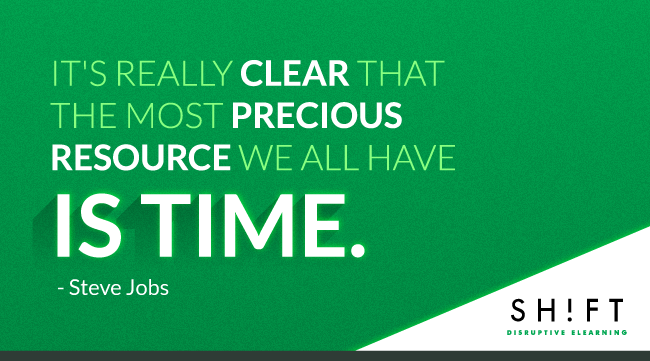A well-designed eLearning course is a treat for the eye, punches in the message hard, keeps you glued to it, and sticks in your mind. But as an instructional designer, you know how challenging it is to develop such a course. From client and SME interviews and chunking content through to storyboarding, developing, and deploying, the eLearning workflow is time-consuming and demands exacting standards. And there are the time and budget constraints. You have to manage your time, so you can keep up with the pressure and still pull off winners.
You learned about some productivity hacks in an earlier post. Here are some more hacks to amp your efficiency and happiness at work.

#1: Get things done by applying timeboxing techniques
Not being organized is one of the biggest productivity killers. The hallmark of a productive instructional designer is that he always delivers on time. He may race against the clock, but he always manages to stay a step ahead. The key to his success is his habit of chunking his time into blocks and fitting only a single task in each block. He then concentrates only on that specific task during the allotted time and consciously shuts off all distractions. This is akin to subtly suggesting to your mind that it cannot wander off during this time.
This method is the complete opposite of the way most of us work today—multi-task. But several research studies have conclusively shown that multitasking is a productivity killer. Our mental energies get divided when we try to focus on all things at one time. Boxing your time compels you to mono-task. It forces you to set realistic goals on what you can achieve during your day.
Read:
- 15 Time Boxing Strategies to Get Things Done
- Timeboxing – The Most Amazing Tool Ever
- 7 Reasons Time-Boxing Is Essential To Real Productivity (Podcast)
#2: Take more breaks
Even machines heat up and burn out if they are made to run continuously. And we are not machines. So unsurprisingly, our minds give up when we work at a stretch. Continuing to work when you are tired and deprived of sleep increases your chances of making mistakes, misinterpreting instructions, and overlooking critical details.
Unfortunately, we live in a society that is obsessed with productivity. We are made to think that the more work we get done, the better are our chances of succeeding in our careers. But what would you choose—give yourself adequate rests and turn in fewer flawlessly-executed projects or slog away day and night and produce masses of shoddy work?
Scientists have shown that the human brain cannot work continuously without rest. So get up from the desk, stretch, bend, and loosen your muscles, or walk around the office. It would be great if you can squeeze in a short nap sometime during the day to recharge your batteries.
Productive people realize the importance of taking breaks between work. That is why, they follow the Pomodoro technique. Focus Booster or Toggl can help you as you perfect this technique.
#3: Declutter your desk (and desktop)
Clutter is not only an eyesore but also zaps your energy without you realizing it. Clutter stresses us out in more ways than you can fathom. Think of all the time you waste hunting for notes on your desk, and you will get the idea.
Some recommended reads:
- Understand clutter’s effect on creativity and productivity
- Guide: How to Declutter Your Workspace
- 12 Tips for an Organized Desk
- Get Your Desktop Under Control: How to Declutter
#4: Adopt good email habits
This is one of the best productivity advice any life coach can ever give you. Emails are the biggest time-wasters we have around us.
Take control of your email habits right NOW because you will continue to be bombarded with emails that pretend to be urgent. Make it a habit to check emails only a few times during the day and at specific hours. Inform your co-workers that you won't be available to reply to emails at certain times of the day, so they know that they will have to call you or walk up to your desk to discuss urgent and important matters.
And here's a piece of information for your peace of mind. Your clients expect you to reply to their emails within one business day. So it is perfectly okay for you to answer them in the afternoon. Besides, after you have worked throughout the day, you will have more to report on the status of the project if you send an email in the afternoon.
#5: Keep your goals in sight at all times
As you may have realized, it takes some time to form good habits and make the effort to be productive. In the meantime, you can motivate yourself by writing down your goals and carrying them around with you. Glance at them occasionally and visualize yourself as the most productive eLearning designer you have ever known. The images you see in your mind's eye will motivate you to reach for the stars.

What you need to remember is that: Productivity is never an accident. It is always the result of a commitment to excellent, intelligent planning, and focused effort. These words by Paul J. Meyer, a globally renowned success and motivation coach, will always remind you that productivity is not in the genes. You have it in you to become more productive.



